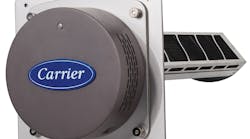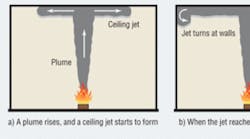Many smoke-control designers do not know there is a minimum smoke-layer depth for atrium smoke-control systems. Section 4.4.1.1 of NFPA 92B, Standard for Smoke Management Systems in Malls, Atria, and Large Spaces, requires that the minimum design depth of a smoke layer be 20 percent of the floor-to-ceiling height, unless an engineering analysis is performed. This 20-percent requirement significantly limits what architects and owners can do with an atrium. In this article, the term “atrium” is used in a generic sense to mean any large-volume space, including stadiums, arenas, and airplane hangars.
It should surprise no one that the 20-percent requirement is not popular with architects and owners. A few years ago, I met a senior engineer who erroneously thought an atrium smoke-control system could be designed for any smoke-layer depth he wanted, even as little as 1 in. Was he ever wrong! The smoke layer that forms under a ceiling has a minimum depth for reasons discussed later in this article. Designs that do not allow the 20 percent mentioned previously may result in exposing building occupants to smoke in a fire situation.
The minimum smoke-layer-depth requirements of NFPA 92B apply to almost all places in the United States because the standard has been adopted by the International Building Code (IBC). A book published by the International Code Council (ICC)1 presents discussions of IBC smoke-control requirements and extensive engineering information to meet those requirements. Regardless of the codes, if the smoke layer is not of sufficient depth, occupants can be exposed to smoke during fire situations.
The December 2008 issue of HPAC Engineering included an article (State-of-the-Art Atrium Smoke Control) that provided an overview of smoke-control technology, including basic concepts, smoke stratification, makeup air, plugholing, and minimum smoke-layer depth.2 Minimum smoke-layer depth, including the reason for the 20-percent requirement, engineering analyses, and design approaches, is explained in greater detail in this article.
WHY 20 PERCENT?
A smoke plume rises above a fire. When the plume reaches the ceiling, smoke flows away from the point of impact in a radial direction, forming a ceiling jet. When the ceiling jet reaches a wall, the smoke flow goes around and under the ceiling jet (Figure 1). The ceiling jet has a depth of about 10 percent of the floor-to-ceiling height, as does the smoke flow under the ceiling jet. This means the smoke-layer depth is about 20 percent of the floor-to-ceiling height. The smoke may descend lower than this minimum smoke-layer depth. Designs need to have sufficient room for the smoke layer to form.
During the 1970s, fundamental research about ceiling jets was conducted by Ron Alpert of Factory Mutual.3,4 Based on his research, Alpert developed correlations for the thickness, temperature, and velocity of ceiling jets. These variables are functions of the height of the ceiling above a fire and the radial distance from the axis of the smoke plume. In most situations, the 10- and 20-percent values mentioned previously are conservatively large. For a detailed treatment of ceiling jets, including Alpert's research, see Chapter 2 of Section 2 of the SFPE Handbook.5 While an engineering analysis could rely on these correlations, there are advantages to using computational fluid dynamics (CFD).
ENGINEERING ANALYSIS
An engineering analysis of minimum smoke-layer depth can be performed with data from full-scale fire tests, scale modeling, or CFD analysis. Full-scale and scale-model tests are relatively expensive, which explains why they are not used often for this kind of analysis. Because zone fire models, such as Consolidated Model of Fire Growth and Smoke Transport (CFAST),6 are well-known and easy to use, some engineers may be tempted to try to use one to analyze minimum smoke-layer depth, but zone models are inappropriate for this application.
In a room or an atrium with a fire, smoke rises and forms a smoke layer as previously described, and there is a gradual transition between the smoke layer and the air below (Figure 2[a]). Zone fire models consider the smoke layer to have uniform properties throughout. In zone fire modeling, the bottom of the smoke layer is considered to be a horizontal plane, so that at 0.01 in. above this plane, the concentration of contaminants is the same as everywhere else in the smoke layer (Figure 2[b]). While zone fire models are useful for many applications, they routinely predict smoke layers of unrealistically small depth in the early stages of fire development. For this reason, zone fire models must not be used to analyze minimum smoke-layer depth.
Page 2 of 2
The idea of CFD modeling is to divide the space of interest into a large number of cells and use a computer program to solve the governing equations for each cell. If that CFD modeling is done properly, it can simulate atrium smoke flow in realistic detail, including smoke-layer formation. Ideal for analysis of a minimum smoke layer, CFD modeling also can simulate a transition zone, which is important for tenability designs, which are discussed later. CFD modeling requires a level of specialized knowledge for proper use, and a CFD simulation can take many hours, even days, as discussed in past articles in HPAC Engineering.2,7
The National Institute of Standards and Technology (NIST) has developed a CFD model specifically for fire applications: Fire Dynamics Simulator (FDS).8Traditionally, CFD models are expensive, but the FDS model, including documentation, can be downloaded free of charge from www.fire.nist.gov/fds.
DESIGN APPROACHES
The IBC requires that the bottom of a smoke layer be at least 6 ft above the highest walking surface that forms a portion of the required means of egress in an atrium. This means that above the highest required means of egress in an atrium, 6 ft plus space for at least the minimum smoke layer should be available. If this much space is not available, other approaches can be used: separation of the top floor(s), the design of a dummy top floor, minimization of foldback, and/or designing for tenability. Engineers are cautioned that alternate approaches need to be based on appropriate engineering analyses.
Separation of top floor(s)
The top floor(s) of an atrium can be separated from the rest of the building to meet the minimum-smoke-layer-depth requirement. This separation can be done with glass so the occupants can see into the atrium, but the required means of egress on the top level(s) are not inside the large open space of the atrium. While this approach may be unpopular with architects, it may be the only practical way to provide the essential space for the formation of a smoke layer.
Design of a dummy top floor
Some atria are designed with a dummy top floor that occupants cannot access. The only people who have access to the dummy top floor are maintenance people. Because these few people are very familiar with the building, they can leave the dummy floor quickly in the event of a fire. Therefore, the code can be interpreted to mean that the walkways on these floors are not part of the required means of egress. As such, the smoke layer can include the dummy floor. If this approach is desired, local code officials should be contacted early in the project to see if they concur with this code interpretation.
Minimization of foldback
As stated previously, when a ceiling jet reaches a wall, it folds under itself, forming the minimum smoke layer. For long, narrow atria, this foldback can be minimized by exhausting smoke from smoke reservoirs located at the ends (Figure 3). There generally are no accepted algebraic equations for analysis of this approach, and it is suggested that CFD modeling be used. Minimum smoke-layer depth in this case is about 10 percent of the floor-to-ceiling height, but a properly done CFD analysis can provide more accurate information. Also, the smoke-control system can become a tenability design.
Designing for tenability
All of the approaches mentioned are based on the idea that occupants need to be kept away from smoke, but another approach is to design systems that provide a tenable environment for occupants during evacuation, even though there may be some contact with diluted smoke. NFPA 92B recognizes such tenability designs. Section 909.1 of the IBC states that smoke-control systems are intended to provide a tenable environment for occupant evacuation or relocation. Tenability designs are an alternative approach to prescriptive code requirements, and local code officials should be notified early in a project that an alternative approach may be used.
A tenability design needs to be based on smoke-transport and tenability analyses. CFD modeling has the potential to realistically simulate smoke transport and is recommended for smoke-transport analysis. The smoke layer has relatively high concentrations of contaminants near the ceiling and lower concentrations in the transition zone. Many tenability designs take advantage of the lower concentrations near the bottom of the smoke layer. A properly conducted CFD analysis can simulate the formation of a smoke layer, including the transition zone between the smoke layer and the air below.
In addition to CFD simulations of smoke transport, a tenability design needs to include a tenability analysis that evaluates the effect of exposure to heat, toxic gases, and reduced visibility. Tenability analysis is too large a topic to deal with in this article, but is treated in “Principles of Smoke Management.”9
A realistic analysis of design fires is essential, and information about design-fire analysis is provided in various sources.1,5,9,10 A design fire provides results in the heat-release rate of fires and the material(s) burned. If an atrium is designed to have almost no materials that can burn, a design fire still needs to account for transient fuels, which are items that may be in the atrium for a short period of time. Examples of transient fuels include trash waiting to be removed, painting solvents, construction materials during a renovation, and new items awaiting movement.
SUMMARY
Many atrium smoke-control designers do not know there is a minimum smoke-layer depth for atrium smoke-control systems. In most places in the United States, the codes require that smoke-layer depth be at least 20 percent of the floor-to-ceiling height, unless there is an engineering analysis. While this requirement is not popular with architects and owners, it is based on accepted research results. If a smoke layer is not of sufficient depth, occupants can be exposed to smoke during fire situations.
Engineering analysis of this minimum layer can be done by comparison with data from full-scale fire tests or by scale modeling, but the common method is by CFD modeling. A properly conducted CFD analysis can simulate the formation of a smoke layer in realistic detail. Such an analysis requires a level of expertise. For designs for which 20-percent space is not available at the top of an atrium, a number of approaches can be used.
REFERENCES
-
Klote, J.H., & Evans, D.H. (2007). A guide to smoke control in the 2006 IBC. Country Club Hills, IL: International Code Council.
-
Klote, J.H. (2008, December). State-of-the-art of atrium smoke control. HPAC Engineering, pp. 36-40.
-
Alpert, R.L. (1972). Calculation of response time of ceiling-mounted fire detectors. Fire Technology, 8, 181-195.
-
Alpert, R.L. (1975). Turbulent ceiling-jet induced by large-scale fires. Combustion Science and Technology, 11, 197-213.
-
SFPE. (2002). The SFPE handbook of fire protection engineering (3rd ed.). Bethesda, MD: Society of Fire Protection Engineers.
-
Peacock, R.D., et al. (2005). CFAST — Consolidated Model of Fire Growth and Smoke Transport (version 6) user's guide. Gaithersburg, MD: National Institute of Standards and Technology.
-
Klote, J.H. (2006 June). CFD: A new way to design atrium smoke control. HPAC Engineering, pp. 19-27.
-
McGrattan, K., et al. (2008). Fire Dynamics Simulator (version 5) — User's guide. Gaithersburg, MD: National Institute of Standards and Technology.
-
Klote, J.H., & Milke, J.A. (2002). Principles of smoke management. Atlanta: American Society of Heating, Refrigerating and Air-Conditioning Engineers.
-
Klote, J.H. (2002, September). Design fires: What you need to know. HPAC Engineering, pp. 43-51.
A smoke-control consultant and member of HPAC Engineering's Editorial Advisory Board, John H. Klote, DSc, PE, developed and conducts a series of smoke-control seminars for the Society of Fire Protection Engineers. For 19 years, he conducted fire research for the National Institute of Standards and Technology. He is a co-author of the books “A Guide to Smoke Control in the 2006 IBC” and “Principles of Smoke Management.”












